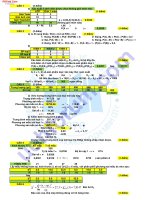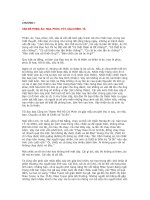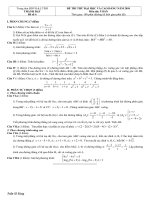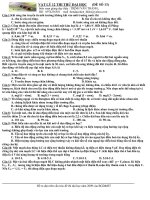Instrucciones de uso - Manual de instruções - Bedienungsanleitung
Bạn đang xem bản rút gọn của tài liệu. Xem và tải ngay bản đầy đủ của tài liệu tại đây (1.27 MB, 37 trang )
100-P Series
| Bedienungsanleitung
Instruction manual | Notice d’emploi
Istruzioni per l’uso | Instrucciones de uso
Gebruiksaanwijzing | Manual de instruỗừes
|
Contents
Contents
Important safety instructions ............................................................................................................................................................. 2
The ew 100 G3 evolution wireless series .......................................................................................................................................... 3
The frequency bank system ........................................................................................................................................................... 3
Product overviews .................................................................................................................................................................................. 4
Overview of the EK 100 G3 diversity receiver ............................................................................................................................ 4
Overview of the SK 100 G3 bodypack transmitter ................................................................................................................... 5
Overview of the SKM 100 G3 radio microphone ........................................................................................................................ 6
Overview of the SKP 100 G3 plug-on transmitter ..................................................................................................................... 7
Overview of the displays of the EK 100 G3 ................................................................................................................................ 8
Overview of the displays of the SK 100/SKM 100/SKP 100 G3 ............................................................................................. 9
Putting the devices into operation ................................................................................................................................................... 10
EK 100 G3 diversity receiver ........................................................................................................................................................ 10
SK 100 G3 bodypack transmitter ............................................................................................................................................... 12
SKM 100 G3 radio microphone .................................................................................................................................................... 13
SKP 100 G3 plug-on transmitter ................................................................................................................................................. 15
Using the devices .................................................................................................................................................................................. 16
Switching the devices on/off ....................................................................................................................................................... 17
Synchronizing a transmitter with the diversity receiver ....................................................................................................... 19
Deactivating the lock mode temporarily ................................................................................................................................... 20
Muting the audio signal or deactivating the RF signal ........................................................................................................... 21
Selecting a standard display ........................................................................................................................................................ 22
Overview of the operating menus .................................................................................................................................................... 23
Synchronizing transmitters with diversity receivers ................................................................................................................... 26
Cleaning the devices ............................................................................................................................................................................. 28
If a problem occurs ... ........................................................................................................................................................................... 29
Specifications ......................................................................................................................................................................................... 31
Manufacturer Declarations ................................................................................................................................................................. 34
Detailed instruction manuals for the individual products can be found on the corresponding product
pages at www.sennheiser.com.
1
Important safety instructions
Important safety instructions
• Read this instruction manual.
• Keep this instruction manual. Always include this instruction manual when passing the
products on to third parties.
• Heed all warnings and follow all instructions in this instruction manual.
• Use only a cloth for cleaning the products.
• Do not place the products near any heat sources such as radiators, stoves, or other devices
(including amplifiers) that produce heat.
• Only use attachments/accessories specified by Sennheiser.
• When replacement parts are required, only use replacement parts specified by Sennheiser
or those having the same characteristics as the original part. Unauthorized substitutions
may result in fire, electric shock, or other hazards.
• Refer all servicing to qualified service personnel.
Servicing is required if the products have been damaged in any way, liquid has been spilled,
objects have fallen inside, the products have been exposed to rain or moisture, do not
operate properly or have been dropped.
• WARNING: To reduce the risk of fire or electric shock, do not use the products near water
and do not expose them to rain or moisture.
Intended use
Intended use of the ew 100 G3 products devices includes:
• having read these instructions especially the chapter “Important safety instructions”,
• using the products within the operating conditions and limitations described in this
instruction manual.
“Improper use” means using the products other than as described in these instructions, or
under operating conditions which differ from those described herein.
2
The ew 100 G3 evolution wireless series
The ew 100 G3 evolution wireless series
With the ew 100 G3 evolution wireless series, Sennheiser offers high-quality state-of-the-art
RF transmission systems with a high level of operational reliability and ease of use. Transmitters and receivers permit wireless transmission with studio-quality sound.
Adaptive diversity
The EK 100 G3 diversity receiver operates on the adaptive diversity principle where the shield
of the line cable is used as the second antenna to provide improved reception.
The frequency bank system
The devices are available in 6 UHF frequency ranges with 1,680 frequencies per frequency
range:
Range A:
516 – 558
Range G:
Range B:
566 – 608
626 – 668
Range C:
734 – 776
Range D:
780 – 822
Range E:
823 – 865
Each frequency range (A–E, G) offers 21 frequency banks with up to 12 channels each:
Channel 1 – frequency preset
Channel 2 – frequency preset
Frequency bank 1 ... 20
Channel 12 – frequency preset
Channel 1 – freely selectable frequency
Channel 2 – freely selectable frequency
Frequency bank U
Channel 12 – freely selectable frequency
Each of the channels in the frequency banks “1” to “20” has been factory-preset to a fixed
frequency (frequency preset).
The factory-preset frequencies within one frequency bank are intermodulation-free.
These frequencies cannot be changed.
For an overview of the frequency presets, please refer to the supplied frequency information
sheet. Updated versions of the frequency information sheet can be downloaded from the
corresponding product page on our website at www.sennheiser.com.
The frequency bank “U” allows you to freely select and store frequencies. It might be that
these frequencies are not intermodulation-free.
3
Product overviews
Product overviews
Overview of the EK 100 G3 diversity receiver
Ã
ằ
ạ
á
ả
à
ắ
à
Operating elements
³ 3.5 mm jack socket, lockable (AF OUT)
(the shielding is used by antenna II)
² SET button
· Antenna I
º Battery compartment
» Operation and battery status indicator,
red LED
(lit = ON/flashing = LOW BATTERY)
¾ Battery compartment cover
¿ RF signal indication, green LED
(lit = RF)
á Infra-red interface
Charging contacts
ả / rocker button (UP/DOWN)
à Battery compartment catches
¹ ON/OFF button
(serves as the ESC (cancel) key in
the operating menu)
Ƹ Display panel, backlit in orange
4
Product overviews
Overview of the SK 100 G3 bodypack transmitter
ằ
Ã
ạ
ả
á
ắ
à
á
Operating elements
Microphone/instrument input (MIC/LINE),
3.5 mm jack socket, lockable
¶ SET button
· MUTE switch
ắ Battery compartment
ằ Antenna
à Battery compartment cover
Operation and battery status indicator,
red LED
(lit = ON/flashing = LOW BATTERY)
¸ Battery compartment catches
´ Audio overmodulation indicator,
yellow LED
(lit = AF PEAK)
Ƹ ON/OFF button,
serves as the ESC (cancel) key in
the operating menu
² Charging contacts
ƹ Display panel, backlit in orange
º ̆/̄ rocker button (UP/DOWN)
¹ Infra-red interface
5
Product overviews
Overview of the SKM 100 G3 radio microphone
ả
ằ
Ã
á
à
ắ
ạ
à
à
Operating elements
Microphone head (interchangeable)
· Name and pick-up pattern of the
microphone head (not visible here)
» Body of radio microphone
¿ Battery compartment (not visible from
outside)
´ Display panel, backlit in orange
² Infra-red interface
¶ Antenna
6
º Color-coded protection ring;
available in different colors
¾ Operation and battery status indicator,
red LED
(lit = ON/flashing = LOW BATTERY)
à Charging contacts
á Multi-function switch:
̄ (DOWN), ̆ (UP) and
(SET)
¹ ON/OFF button,
serves as the ESC (cancel) key in the
operating menu
Product overviews
Overview of the SKP 100 G3 plug-on transmitter
Ã
ằ
ả
ắ
à
á
Operating elements
Microphone input, XLR-3 socket
(female, unbalanced)
· Mechanical locking ring of
XLR-3 socket
» Infra-red interface
¿ Display panel, backlit in orange
¶ Operation and battery status indicator,
red LED
(lit = ON/flashing = LOW BATTERY)
º ON/OFF button
(serves as the ESC (cancel) key in the
operating menu)
¾ MUTE switch
´ UP button ()
à SET button
DOWN button ()
á Battery compartment cover
7
Product overviews
Overview of the displays of the EK 100 G3
After switch-on, the diversity receiver displays the standard display “Frequency/Name”.
For further illustrations and examples of the different standard displays, refer to page 22.
The display backlighting is automatically reduced after approx. 20 seconds.
ቢ ባ
ቤ
ብ
533.875 MHz
ew100 G3
ቦ
P MUTE
RF AF
ቩ
ቨ
ቧ
Display
Meaning
ቢ RF level “RF”
(Radio Frequency)
Diversity display:
Antenna input I is active
Antenna input II is active
RF
ባ Audio level “AF”
(Audio Frequency)
RF signal level:
Field strength of the received signal
Squelch threshold level
Modulation of the transmitter
Peak hold function
When the display shows full deflection, the audio
input level is excessively high.
AF
ቤ Frequency
Current receiving frequency
ብ Name
Freely selectable name of the receiver
ቦ Lock mode icon
Lock mode is activated
ቧ Battery status
Charge status:
approx. 100%
approx. 70%
approx. 30%
Charge status is critical; in addition,
the red LOW BATT LED » is flashing.
ቨ Muting function
“MUTE”
or
line output level
AF OUT
ቩ Pilot tone “P”
8
“Mute” is only displayed on the “Frequency/Name” standard
display (see page 22) when no RF signal is being received.
The diversity receiver then does not output an audio signal.
The line output level AF OUT is only displayed on the
“Frequency bank/Channel/Name” standard display
(see page 22).
Activated pilot tone evaluation
Product overviews
Overview of the displays of the SK 100/SKM 100/SKP 100 G3
After switch-on, the transmitter displays the standard display “Frequency/Name”.
For further illustrations and examples of the different standard displays, refer to page 22.
The display backlighting is automatically reduced after approx. 20 seconds.
ቢ
ባ ቤ
ብ
533.875 MHz
ew100 G3
AF
ቦ
P MUTE
ቧ
ቨ
ቩ
Display
Meaning
ቢ Audio level “AF”
Modulation of the SK/SKM/SKP 100 G3
with peak hold function.
ባ Frequency
Current transmission frequency
ቤ Name
Freely selectable name of the transmitter
ብ Transmission icon
RF signal is being transmitted
ቦ Lock mode icon
Lock mode is activated
ቧ Pilot tone “P”
Pilot tone transmission is activated
ቨ “MUTE”
Audio signal is muted
ቩ Battery status
Charge status:
approx. 100%
approx. 70%
approx. 30%
Charge status is critical, the red
LOW BATTERY LED ả//ắ is flashing:
P
ả
ắ
9
Putting the devices into operation
Putting the devices into operation
EK 100 G3 diversity receiver
Inserting the batteries/accupack
For powering the diversity receiver, you can either use two 1.5 V AA size batteries or the
rechargeable Sennheiser BA 2015 accupack.
̈ Open the battery compartment by pushing the two catches µ in the direction of the
arrows and open the cover ắ.
ắ
à
ắ
Insert the two batteries or the accupack as shown above. Please observe correct polarity
when inserting the batteries/accupack.
̈ Close the battery compartment by pressing on the center of the cover ¾.
The battery compartment cover ¾ locks into place with an audible click.
Charging the accupack
To charge the BA 2015 accupack:
̈ Insert the diversity receiver into the L 2015 charger (optional accessory).
The L 2015 simultaneously charges up to two devices, e.g. two diversity receivers or
one diversity receiver and one SK 100 G3 bodypack transmitter.
The L 2015 charger can only charge the BA 2015 accupack. Standard batteries
(primary cells) or individual rechargeable battery cells cannot be charged.
10
Putting the devices into operation
Mounting the diversity receiver to a camera
Use the supplied CA 2 camera adapter to mount the receiver to a camera’s flash mount.
̈ Determine where on the perforated plate ƹ the flash mount adapter ƺ will need to be
fastened so that the receiver can best be attached to the camera.
ƺ
ƹ
̈ At this position, place a square nut ƻ under the perforated plate ƹ.
̈ Fasten the flash mount adapter ƺ to the perforated plate ƹ using the square nut ƻ.
̈ Lift one side of the belt clip Ƽ as shown.
ƻ
Ƽ
̈ Press down the belt clip Ƽ at one fixing point and pull it out of the receiver housing.
̈ Repeat for the other side.
̈ Place the perforated plate ƹ onto the rear of the receiver.
̈ Reinsert the belt clip Ƽ.
̈ Use one of the supplied line cables to connect the line input of the camera to the
socket ³.
³
The shield of the line cable serves as the antenna for the second diversity section.
11
Putting the devices into operation
SK 100 G3 bodypack transmitter
Inserting the batteries/accupack/Charging the accupack
The procedure is the same as for the EK 100 G3 diversity receiver:
To insert the batteries/accupack:
̈ Read the chapter “Inserting the batteries/accupack” on page 10.
To charge the accupack:
̈ Read the chapter “Charging the accupack” on page 10.
Connecting the microphone cable/line cable
The audio input is designed for the connection of condenser microphones. DC powering of the
condenser microphones is via the audio input MIC/LINE ³ (3.5 mm jack socket).
̈ Use one of the recommended Sennheiser microphones or the optional CL 2 line cable.
̈ Connect the 3.5 mm jack plug ƺ from the Sennheiser cable to the 3.5 mm jack socket
MIC/LINE ³.
ƺ
̈ Lock the 3.5 mm jack plug by screwing down the coupling ring ƻ of the cable.
̈ Via the operating menu, adjust the sensitivity of the microphone/line input.
³
ƻ
Attaching and positioning the corresponding microphones
ME 2/ME 4
̈ Use the microphone clip Ƽ to attach the microphone to clothing (e.g. tie, lapel).
The ME 2 clip-on microphone (shown on the right in the diagram) has an omni-directional
pick-up pattern. It is therefore not necessary to position it precisely.
̈ Attach the ME 2 microphone as close as possible to the sound source.
Ƽ
The ME 4 clip-on microphone (shown on the left in the diagram) has a cardioid pick-up
pattern.
̈ Position the ME 4 microphone so that its sound inlet is directed towards the sound source
(e.g. mouth).
12
Putting the devices into operation
Attaching the bodypack transmitter to clothing
You can use the belt clip ƽ to attach the bodypack transmitter to clothing (e.g. belt, waistband).
The belt clip is detachable so that you can also attach the transmitter with the antenna
pointing downwards. To do so, withdraw the belt clip ƽ from its fixing points and attach it
the other way round. The belt clip ƽ is secured so that it cannot slide out of its fixing points
accidentally.
To detach the belt clip:
̈ Lift one side of the belt clip as shown in the diagram on the right-hand side.
̈ Press down the belt clip at one fixing point and pull it out of the transmitter housing.
̈ Repeat for the other side.
ƽ
SKM 100 G3 radio microphone
̈ Only hold the radio microphone by its body.
If you touch the antenna of the radio microphone during operation, the transmitter’s range will be considerably reduced!
Inserting the batteries/accupack
For powering the radio microphone, you can either use two 1.5 V AA size batteries or the
rechargeable Sennheiser BA 2015 accupack.
»
̈ Unscrew the lower part of the radio microphone from the radio microphone’s body » by
turning it counterclockwise.
When unscrewing the radio microphone during operation, the muting function is
automatically activated. “MUTE” appears on the display panel.
When screwing the lower part of the radio microphone back to the radio microphone’s body, the muting is canceled.
̈ Slide back the lower part of the radio microphone as far as it will go.
̈ Open the battery compartment cover Ƹ (see page 14).
̈ Insert the batteries or the BA 2015 accupack as shown on the battery compartment
cover. Observe correct polarity when inserting the batteries/accupack (see page 14).
13
Putting the devices into operation
Ƹ
Ƹ
̈ Close the battery compartment cover Ƹ.
̈ Push the battery compartment into the radio microphone’s body.
̈ Screw the lower part of the radio microphone back to the radio microphone’s body.
Charging the accupack
To charge the radio microphone with the BA 2015 accupack (optional accessory) installed:
̈ Use the LA 2 charging adapter to insert the radio microphone into the L 2015 charger
(charger and charging adapter are available as optional accessories).
Changing the microphone head
The microphone head ³ is easy to change.
̈ Unscrew the microphone head ³.
³
Do not touch the contacts of the radio microphone nor the contacts of the microphone head ³. The contacts can become dirty or damaged if touched.
When unscrewing the microphone head ³ during operation, the muting function is
automatically activated. “MUTE” appears on the display panel.
When screwing the microphone head ³ back to the radio microphone, the muting
is canceled.
̈ Screw the desired microphone head to the radio microphone.
The radio microphone is operational again.
14
Putting the devices into operation
Changing the color-coded protection ring
The color-coded protection ring º prevents the multi-function switch ¸ from accidental
operation. Protection rings in different colors are available as accessories. The protection
rings allow you to clearly identify each radio microphone.
̈ Remove the color-coded protection ring as shown in the left-hand diagram.
̈ Put on a new protection ring as shown in the right-hand diagram.
º
º
ᕨ
ᕨ
SKP 100 G3 plug-on transmitter
Inserting the batteries/accupack
For powering the plug-on transmitter, you can either use two 1.5 V AA size batteries or the
rechargeable Sennheiser BA 2015 accupack.
̈ Slide the battery compartment cover ¸ in the direction of the embossed arrow and open
the cover.
̈ Insert the two batteries or the accupack as shown below. Please observe correct polarity
when inserting the batteries/accupack.
̈ Close the battery compartment.
The battery compartment cover ¸ locks into place with an audible click.
¸
¸
Charging the accupack
̈ Remove the BA 2015 accupack (optional accessory).
̈ Insert the BA 2015 accupack into the L 2015 charger (accupack and charger are optional
accessories):
The L 2015 charger can only charge the BA 2015 accupack. Standard batteries
(primary cells) or individual rechargeable battery cells cannot be charged.
15
Using the devices
Plugging the plug-on transmitter onto a microphone
̈ Plug the microphone’s XLR-3M socket onto the transmitter’s XLR-3F socket ³.
³
·
̈ Tighten the locking ring · in the direction of the arrow.
The transmitter uses the microphone body as an antenna – therefore microphones
with a metal casing should be used for best signal transmission.
Using the devices
To establish a transmission link, proceed as follows:
1. Switch the diversity receiver on.
2. Switch a transmitter on.
The transmission link is established and the diversity receiver’s RF level display “RF”
reacts.
If you cannot establish a transmission link between transmitter and diversity receiver:
̈ Make sure that transmitter and diversity receiver are set to the same frequency bank and
to the same channel.
̈ If necessary, read the chapter “If a problem occurs ...” on page 29.
It is vital to observe the following notes:
̈ Make sure that the desired frequencies are listed in the enclosed frequency
information sheet.
̈ Make sure that the desired frequencies are approved and legal in your country
and, if necessary, apply for an operating license.
16
Using the devices
Switching the devices on/off
EK 100 G3 diversity receiver
To switch the diversity receiver on:
̈ Push the two battery compartment catches à and open the battery compartment
cover ắ.
ằ
ạ
à
ắ
à
Press the ON/OFF button ¹.
The red ON LED » lights up and the standard display “Frequency/Name” appears on the
display panel.
To switch the diversity receiver off:
̈ Press the ON/OFF button ¹ until “OFF” appears on the display panel.
The red ON LED » goes off and the diversity receiver switches off.
When in the operating menu, pressing the ON/OFF button ¹ will cancel your entry
(ESC function) and return you to the current standard display.
17
Using the devices
SK 100 G3 bodypack transmitter, SKM 100 G3 radio microphone and
SKP 100 G3 plug-on transmitter
P
á
ắ
ạ
á
á
ả
ả
à
à
To switch your transmitter on (online operation):
SK 100 G3
SKM 100 G3
SKP 100 G3
̈ Push the two catches ¸ ̈ Briefly press the ON/OFF ̈ Briefly press the ON/OFF
and open the battery
button ¹.
button º.
compartment cover µ.
The radio microphone
The plug-on transmitter
transmits an RF signal.
transmits an RF signal.
̈ Briefly press the ON/OFF
The red ON LED ¾ lights
The red ON LED ¶ lights
button Ƹ. The bodypack
up and the standard
up and the standard
transmitter transmits an
display “Frequency/
display “Frequency/
RF signal.
Name” appears on the
Name” appears on the
The red ON LED ¿ lights
display panel. The transdisplay panel. The transup and the standard
mission icon ብ is
mission icon ብ is
display “Frequency/
displayed.
displayed.
Name” appears on the
display panel. The transmission icon ብ is
displayed.
You can switch your transmitter on and deactivate the RF signal on switch-on.
For more information, refer to page 19.
To switch your transmitter off:
̈ If necessary, deactivate the lock mode (see page 20).
̈ Press the ON/OFF
button Ƹ until “OFF”
appears on the display
panel.
The display panel turns
off. The red ON LED ¿
goes off.
̈ Press the ON/OFF
button ¹ until “OFF”
appears on the display
panel.
The display panel turns
off. The red ON LED ¾
goes off.
̈ Press the ON/OFF
button º until “OFF”
appears on the display
panel.
The display panel turns
off. The red ON LED ¶
goes off.
When in the operating menu, pressing the ON/OFF button will cancel your entry
(ESC function) and return you to the current standard display.
18
Using the devices
To switch your transmitter on and to deactivate the RF signal on switch-on (offline operation):
SK 100 G3
SKM 100 G3
SKP 100 G3
̈ Keep the ON/OFF
button Ƹ pressed until
“RF Mute On?” appears
on the display panel.
̈ Keep the ON/OFF
button ¹ pressed until
“RF Mute On?” appears
on the display panel.
̈ Keep the ON/OFF
button º pressed until
“RF Mute On?” appears
on the display panel.
̈ Press the SET button ¶. ̈ Press the multi-function ̈ Press the SET button à.
switch á.
The transmission frequency is displayed but the transmitter does not transmit an
RF signal.
The transmission icon ብ is not displayed.
533.875 MHz
ew100 G3
AF
533.875 MHz
ew100 G3
ብ
P MUTE
AF
P MUTE
533.875 MHz
ew100 G3
ብ
AF
ብ
P MUTE
Use this function to save battery power or to prepare a transmitter for use during
live operation without causing interference to existing transmission links.
To activate the RF signal:
̈ Briefly press the ON/OFF ̈ Briefly press the ON/OFF ̈ Briefly press the ON/OFF
button Ƹ.
button ¹.
button º.
“RF Mute Off” appears
“RF Mute Off” appears
“RF Mute Off” appears
on the display panel.
on the display panel.
on the display panel.
̈ Press the SET button ¶. ̈ Press the multi-function ̈ Press the SET button µ.
The transmission icon ብ
switch ¸.
The transmission icon ብ
is displayed again.
The transmission icon ብ
is displayed again.
is displayed again.
Synchronizing a transmitter with the diversity receiver
You can synchronize a suitable transmitter of the ew 100 G3 series with the diversity
receiver. During synchronization, the following parameters are transferred to the transmitter:
Setting
Transferred parameters
“Frequency Preset”
Currently set frequency
“Name”
Freely selectable name currently set on the receiver
“Pilot Tone”
Current pilot tone setting of the receiver (“Inactive”/“Active”)
19
Using the devices
To transfer the parameters:
̈ Switch the transmitter and the diversity receiver on.
̈ On the receiver, call up the “Sync” menu item.
“Sync” appears on the display panel of the diversity receiver.
̈ Place the infra-red interface of the transmitter (see page 5 to page 7) in front of the
infra-red interface of the diversity receiver ¸.
¸
The parameters are transferred to the transmitter. When the transfer is completed, “ ”
appears on the display panel of the diversity receiver. The receiver then switches back to the
current standard display.
To cancel the transfer:
Press the ON/OFF button ¹ on the diversity receiver.
“ ” appears on the display panel of the receiver. “ ” also appears if no suitable transmitter was found (wrong frequency range/wrong generation).
Deactivating the lock mode temporarily
You can activate or deactivate the automatic lock mode via the “Auto Lock” menu item (see
page 23). If the lock mode is activated, you have to temporarily deactivate it In order to be
able to operate the devices:
P
á
ả
ả
à
EK 100 G3/SK 100 G3
SKM 100 G3
SKP 100 G3
̈ Press the SET
button (EK) or ả
(SK).
Press the multifunction switch á.
Press the SET
button µ.
“Locked” appears on the display panel.
̈ Press the rocker
button ả (EK) or
(SK).
Move the multifunction switch á
upwards/downwards.
Press the
UP button ´/
DOWN button ².
“Unlock?” appears on the display panel.
̈ Press the SET
button ² (EK) or ¶
(SK).
̈ Press the multifunction switch ¸.
The lock mode is temporarily deactivated.
20
̈ Press the SET
button µ.
Using the devices
How you are using the devices determines how long the lock mode remains deactivated:
When you are in the operating menu
The lock mode remains deactivated until you exit the operating menu.
When one of the standard displays is shown
The lock mode is automatically activated after 10 seconds.
The lock mode icon flashes prior to the lock mode being activated again.
Muting the audio signal or deactivating the RF signal
You can deactivate the RF signal of the transmitters (SKM 100 G3, SK 100 G3,
SKP 100 G3) on switch-on. For more information, refer to the chapter “Switching the
devices on/off” on page 17.
Using the ON/OFF button, you can also activate/deactivate the transmitters’ RF
signal during operation. To do so, briefly press the ON/OFF button and proceed as
described on page 19.
SK 100 G3/SKP 100 G3
·
ብ
533.875 MHz
ew100 G3
AF
¾
P MUTE
ቨ
The MUTE switch · (SK)/ ¾ (SKP) allows you to mute the audio signal or to deactivate the
RF signal. Via the “Mute Mode” menu item, you can set the desired function of the MUTE
switch · (SK)/ ¾ (SKP):
Setting
Slide the MUTE switch · / ¾ ... Function
“AF On/Off”
... to the left (position MUTE)
Mutes the audio signal
... to the right
Unmutes the audio signal
... to the left (position MUTE)
Deactivates the RF signal
(offline operation)
... to the right
Activates the RF signal
(online operation)
“RF On/Off”
“Disabled”
No function
̈ From the “Mute Mode” menu item, select the desired setting (see page 25).
̈ Exit the operating menu.
̈ Slide the MUTE switch · (SK)/ ¾ (SKP) to the left, to the position MUTE.
The transmitter reacts as indicated in the table.
21
Using the devices
The current state of the muting function or the RF signal is displayed on the display panel of
the transmitter:
Audio signal is muted
“MUTE” ቨ is displayed
Transmitter’s display panel:
Audio signal is activated (muting is canceled)
“MUTE” ቨ is not displayed
Transmitter’s display panel:
RF signal is deactivated
Transmission icon ብ is not displayed,
“MUTE” ቨ is displayed
Transmitter’s display panel:
RF signal is activated
Transmission icon ብ is displayed,
“MUTE” ቨ is not displayed
Transmitter’s display panel:
Selecting a standard display
EK 100 G3
ON/OFF
̈ Briefly press the ON/OFF button to select a standard display.
Contents of the display
533.875 MHz
ew100 G3
RF AF P MUTE
B.Ch: 20.12
ew100 G3
RF AF P
0
22
Selectable standard display
“Frequency/Name”
with “MUTE” display ቨ
“Frequency bank/Channel/Name”
with display of the line output level “AF OUT” ቨ
Overview of the operating menus
SK 100/SKM 100/SKP 100 G3
To select a standard display:
SK 100 G3
SKM 100 G3
̈ Press the rocker
button.
Contents of the display
533.875 MHz
ew100 G3
AF
̈ Press the UP
button/DOWN
button.
Selectable standard display
“Frequency/Name”
“Channel/Frequency”
P MUTE
ew100 G3
B.Ch: 20.12
AF
SKP 100 G3
P MUTE
B.Ch: 20.12
533.875 MHz
AF
̈ Move the multifunction switch.
“Name/Channel”
P MUTE
Overview of the operating menus
For more detailed information on the operating menus, refer to the individual
instruction manuals of the devices. These instruction manuals can be downloaded from the corresponding product pages at www.sennheiser.com.
EK 100 G3
Main menu
“Menu”
Sync
Squelch
Easy Setup
Frequency Preset
Name
AF Out
Auto Lock
Advanced
Extended menu
Exit
“Advanced Menu”
“Easy Setup”
Reset List
Current List
Scan New List
Exit
Tune
Pilot Tone
LCD Contrast
Reset
Software Revision
Exit
23
Overview of the operating menus
When one of the standard displays is shown on the display panel, you can get into the main
menu by pressing the SET button ². The extended menu “Advanced Menu” and the “Easy
Setup” menu can be accessed via the corresponding menu items.
Display
Function of the menu item
Main menu “Menu”
Sync
Synchronizes a transmitter with the diversity receiver
Squelch
Adjusts the squelch threshold
Adjustment range: “Low”, “Middle”, “High”, can be switched off
Special function (for servicing purposes only): With the squelch threshold set to “Low”,
you switch the squelch off by keeping the DOWN rocker button ¶ pressed for 3 seconds.
If you then press the UP button ¶, you switch the squelch on again.
Easy Setup
Scans for unused frequency presets, releases and selects frequency presets
Frequency Preset
Changes the frequency bank and the channel
Name
Enters a freely selectable name
AF Out
Adjusts the audio output level
Adjustment range: –30 dB to +12 dB, adjustable in steps of 6 dB
Auto Lock
Activates/deactivates the automatic lock mode
Advanced
Calls up the extended menu “Advanced Menu”
Exit
Exits the operating menu and returns to the current standard display
“Easy Setup”
Reset List
Releases all locked frequency presets
Current List
Selects an unused frequency preset
Scan New List
Automatically scans for unused receiving frequencies (frequency preset scan)
Exit
Exits the menu “Easy Setup” menu and returns to the main menu
Extended menu “Advanced Menu”
Tune
Sets the receiving frequencies for the frequency bank “U”
Sets a channel and a receiving frequency for the frequency bank “U”:
̈ Select this menu item and call it up by pressing the SET button ² until the channel
selection appears.
Pilot Tone
Activates/deactivates the pilot tone evaluation
LCD Contrast
Adjusts the contrast of the display panel
Reset
Resets the diversity receiver
Software Revision
Displays the current software revision
Exit
Exits the extended menu “Advanced Menu” and returns to the main menu
24









